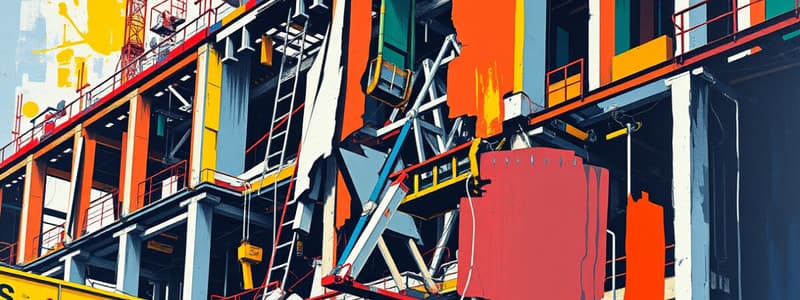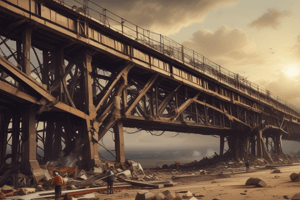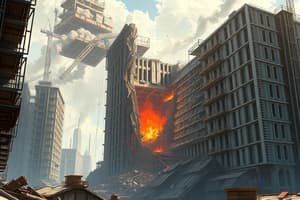Podcast
Questions and Answers
What characterizes a 90-degree wall collapse?
What characterizes a 90-degree wall collapse?
- The wall collapses outward in a fan-like shape
- The wall remains partially standing
- The wall collapses as one entire unit straight down (correct)
- The wall collapses inward in sections
What defines an A-frame floor collapse?
What defines an A-frame floor collapse?
- A collapse where all supports fail and the floor falls flat
- A collapse where the floor remains mostly intact but tilts
- A collapse where the floor bends downward in the middle
- A collapse where one end of the floor is supported by an interior wall, creating two void spaces (correct)
What occurs during a cantilever floor collapse?
What occurs during a cantilever floor collapse?
- The floor collapses with no voids created
- One end of the floor remains supported while the other end is unsupported, creating potential voids (correct)
- The floor collapses in a v-shape
- The entire floor collapses evenly
What is a curtain wall collapse most associated with?
What is a curtain wall collapse most associated with?
Which statement best describes a global (total) collapse?
Which statement best describes a global (total) collapse?
In a collapse where the floor remains intact but tilts, which type of collapse is being described?
In a collapse where the floor remains intact but tilts, which type of collapse is being described?
What is NOT a characteristic of a 90-degree wall collapse?
What is NOT a characteristic of a 90-degree wall collapse?
Which type of wall is primarily associated with curtain wall collapse?
Which type of wall is primarily associated with curtain wall collapse?
What characterizes a complete failure of the entire building?
What characterizes a complete failure of the entire building?
What does an inward outward collapse specifically involve?
What does an inward outward collapse specifically involve?
Which type of structure is most prone to lean over collapse?
Which type of structure is most prone to lean over collapse?
What forms as a result of a lean-to-floor collapse?
What forms as a result of a lean-to-floor collapse?
What is the defining feature of a pancake collapse?
What is the defining feature of a pancake collapse?
How is a partial collapse defined?
How is a partial collapse defined?
What typically initiates a progressive collapse?
What typically initiates a progressive collapse?
What is an example of a secondary collapse?
What is an example of a secondary collapse?
What is meant by situational awareness in firefighting?
What is meant by situational awareness in firefighting?
What occurs during a V-shaped floor collapse?
What occurs during a V-shaped floor collapse?
Flashcards are hidden until you start studying
Study Notes
Building Collapse Types
-
90-degree Wall Collapse: Characterized by walls collapsing as a single unit straight down, posing significant risks to both people and property.
-
A-frame Floor Collapse: Occurs when one end of the floor remains supported by an interior wall, leading to the creation of two void spaces beneath the unsupported section.
-
Cantilever Floor Collapse: Features one end of the floor supported while the other end is unsupported, resulting in potential voids that can be hazardous.
-
Curtain Wall Collapse: Involves non-load-bearing walls, like brick veneer, that collapse vertically downward resembling a curtain, which can result in major safety concerns.
-
Global (Total) Collapse: Refers to a complete failure of the entire structure, compromising all levels and posing extreme danger.
-
Inward Outward Collapse: Defined by the exterior wall failing horizontally, where the upper part collapses inward and the lower part breaks outward.
-
Lean Over Collapse: Typically occurs in wood-frame buildings that become unstable and lean at upper levels, leading to structural failures.
-
Lean-To-Floor Collapse: Results in a triangular void created by one end of the floor being partially supported, which can create dangerous conditions.
-
Pancake Collapse: Involves the stacking of floors and roof flat on each other, creating a compact mass and complicating rescue efforts.
-
Partial Collapse: Represents the failure of a part of a building, such as a section of the floor collapsing, rather than the entire structure giving way.
-
Progressive Collapse: Triggered by local structural damage that initiates a chain reaction of failures throughout the building, posing large scale catastrophic risks.
-
Secondary Collapse: Occurs as an additional failure after an initial collapse, often caused by shifts in load and further destabilization.
-
Situational Awareness in Firefighting: Encompasses the perception of one’s surroundings and understanding of dynamic conditions to anticipate potential outcomes during emergencies.
-
V-shaped Floor Collapse: In this collapse type, the floor fails near the center while the edges remain partially supported, creating two significant voids that can affect safety and stability.
Studying That Suits You
Use AI to generate personalized quizzes and flashcards to suit your learning preferences.



